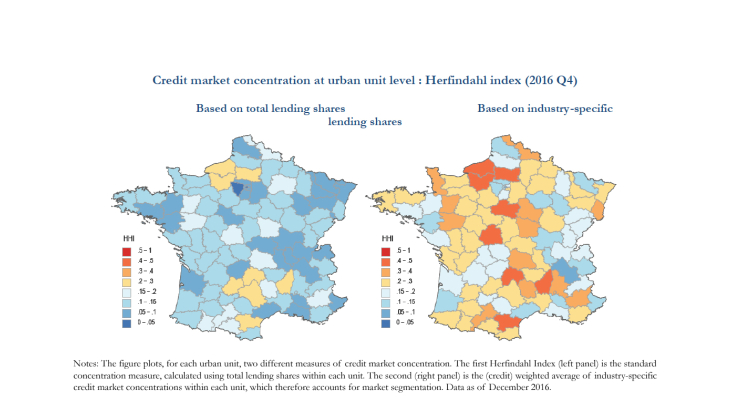This paper explores whether banks gain market power through differentiation and specialization and the implications of such a credit market segmentation for small firms’ access to credit. This question is of first order importance to assess competition in the banking market. Lenders that may appear to compete fiercely in an undifferentiated credit market, may in fact enjoy market power in some market segments by tailoring their products and services to particular clients or industries. While the banking literature has extensively analyzed the market power banks gain thanks to the private information gathered through the lending interaction with small borrowers (e.g. Rajan 1992; Berger and Udell 1995), we want to characterize the complementary role of the industry segmentation of the small-firm credit market. As illustrated in the figure below, aggregate concentration measures (lhs) indeed depart from credit concentrations calculated industry-by-industry (rhs), showing that credit markets are segmented by industry.
We use unique regulatory data for the universe of bank-firm relationships in France, from 2010 to 2017, to construct measures of bank-branch industry specialization in narrowly defined geographical credit markets. We identify banks’ sector of specialization using abnormally large portfolio shares. Industry specialization appears in the data as a widespread but local, branch-level, phenomenon. More than a third of bank branches in France come out as being specialized in supplying credit to small firms in at least one specific industry but different branches of the same bank generally exhibit different industrial specializations.
Next, we turn to examining whether firm’s elasticity of credit substitution across banks is smaller when specialized banks offer differentiated services. For example, a firm in the construction industry will find more difficult or costly to substitute credit obtained from a bank that is specialized in the construction industry than credit obtained from a generalist bank. Our empirical research design exploits borrower reallocations across branches due to some 700 branch closures from 2010 to 2017. Branch closures did not end bank-borrower relationships: all accounts were transferred to nearby branches of the same bank effectively inducing plausibly exogenous variation in the match between the borrower’s industry and the industry of specialization of the branch.
We find evidence of a significant drop in the total of credit granted by a bank to a small firm whenever the firm’s account is reallocated to a new branch. Total credit drops by 12% on average over the three years following the closing. Part of this decline is substituted with more credit from other banks. However, the average firm’s total credit drops permanently by about 4% after reallocation, relative to other firms in the same area and industry.
We then document the heterogeneity of this decline in equilibrium credit by the match between the borrower’s industry and the industry of specialization of the closing and absorbing branches. We find that the magnitude of the decline in credit doubles when a firm’s accounts are reallocated from a branch that specializes in its industry to a branch that does not. We show that this effect cannot be attributed to the change in distance or in competition associated with the closing, as well as the loss of a long lending relationship. The results are strongly suggestive of a segmented bank credit market, where bank specialization by industry increases the cost of substituting bank sources of financing for small firms.
